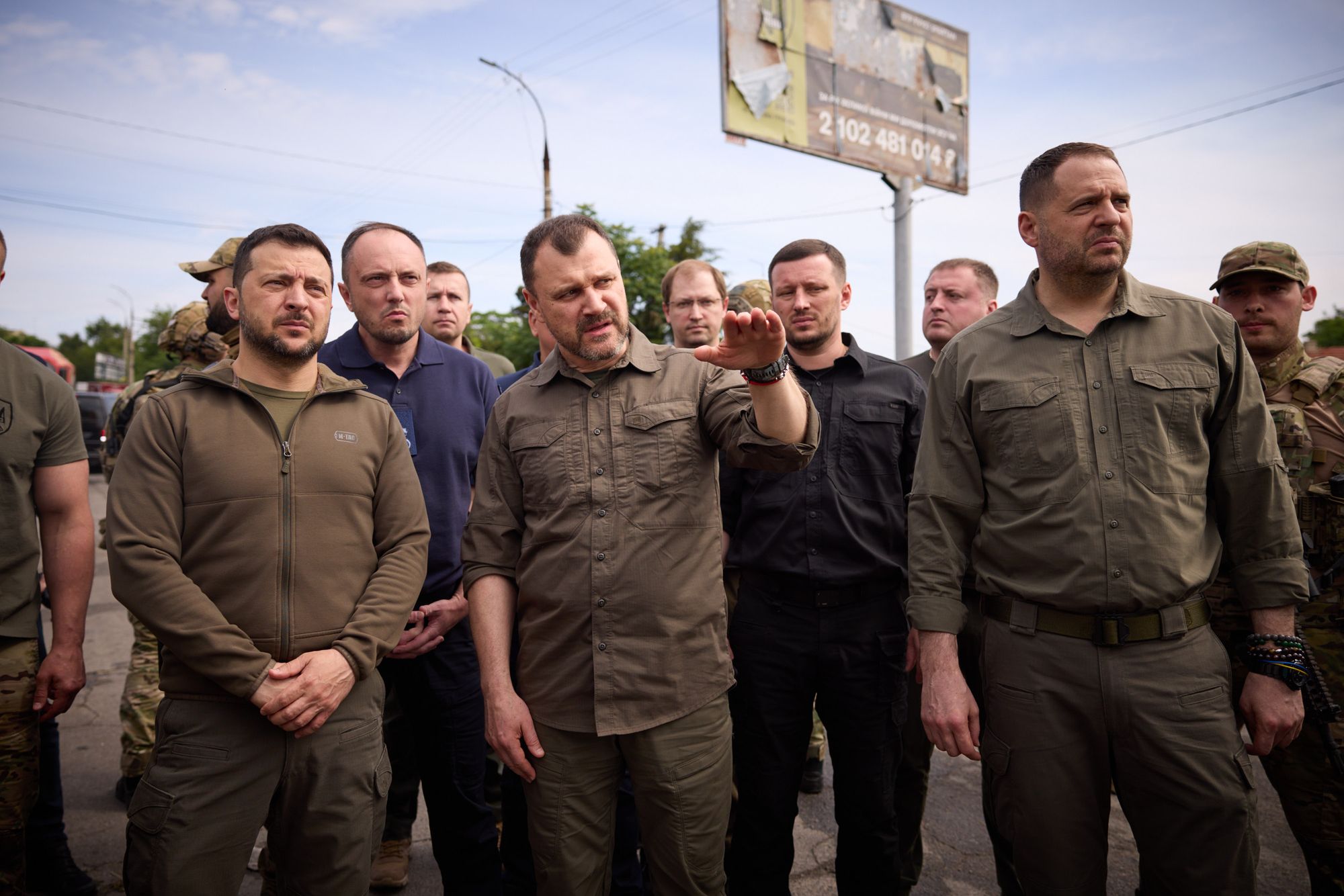Saving lives from Russia’s flood: Inside inundated, shelled Kherson

KHERSON – Since Russia’s full-scale war began, first came eight months of terror under occupation, then came seven months of intense shelling across the river, then came the river itself to Kherson.
Over 24 hours after Russian forces destroyed the Kakhovka Hydroelectric Power Plant and its massive dam over the Dnipro River on June 6, Korabelna Square in the center of Kherson was a hive of activity.
Still rising by the hour, floodwaters had covered the roundabout completely, creating a new riverbank on the sloped road leading to the city center, which sits on higher ground.
Boats of all types, from rubber dinghies to iron fishing boats, docked and departed at the water’s edge in the space of minutes. Steering them were a mix of soldiers, emergency services workers, volunteers, and most of all, local residents with their own boats.
Also at work were marvels of modern Ukrainian engineering in the hands of the State Emergency Service: Bohun all-terrain vehicles, first released in 2020, with huge, ribbed rubber tires that allow them to drive straight into the water from dry land.
With the arriving watercraft came people of all ages, evacuated from areas under meters of water from low-lying districts of the city.
Many had issues with mobility, and were transferred directly to ambulances. Others just stood watching with their belongings, frozen in disbelief and unsure what to do next.
“Some of our neighbors from the first floor didn't want to evacuate, they came up to our place to wait it out,” said Iryna Tatochenko, 63, after climbing out of a boat.
“A lot of people are climbing to higher floors, our people are kind, we help each other, everything will be ok.”
According to the State Emergency Service, 2,339 people have been recorded as evacuated so far from flood-affected areas, though with the number of informal evacuation initiatives ongoing the number is likely higher.
With Russia having occupied the Kakhovka hydoelectric plant since the first days of the full-scale war, and been in full control of the side where the huge breach suddenly appeared, Moscow’s responsibility for the disaster is not under question, according to Ukrainian officials.
“There can be no doubt at all that this was done by Russia, the president warned of the threat that they would do exactly this back in October last year already,” Infrastructure Minister Oleksandr Kubrakov said during a press briefing in Kherson.
Russia’s motivation, according to Kubrakov, was primarily a military one, made in desperation as a large-scale Ukrainian counteroffensive begins to gain momentum along the Zaporizhzhia Oblast front line.
“They feel that our counteroffensive has begun, they see the situation is changing on the battlefield, they need all the forces they can,” he said.
“They understood that we could also attack from here (across the Dnipro in Kherson Oblast). They did this deliberately to make this impossible for a certain amount of time.”

At the briefing, Kubrakov described the scale of some of the other consequences of the dam’s destruction, beyond the immediate threat to human lives in flooded areas.
The flooding of the low-lying areas in and around the river, where both sides held front-line positions stretching over 80 kilometers, has led to the release of thousands of land mines into the water, with photos of the floating objects already emerging on social media. Kubrakov reported that demining would be the authorities’ first priority once the water receded.
The disaster also has an immense ecological dimension. According to the minister, the Nyzhnodniprovsk, Velykyi Luh and Kaminska Sich national parks in southern Ukraine “could disappear forever.”
“The world must reply with action, not words,” Kurbakov said in conclusion.
Saved from the waters
In Kherson’s western Shumenskyi district, residents stood and watched as water slowly but steadily trickled up the courtyard. Monitoring the speed of the inundation, a soldier at the scene was drawing lines on the pavement with timestamps, marking where the water would likely rise to with each passing half hour.
Around the corner of an apartment building, three men in full-body rubber suits emerged. With them was 36-year-old resident Oksana Starostina, and on the shoulders of one of the men, her nine-year-old son Kostiantyn.
Speaking briefly to the Kyiv Independent before being whisked off in a car, Starostina said she and her son would head to relatives in Uzhhorod in western Ukraine.
“We are fine, it’s the people on the other (occupied) side, nobody is evacuating them, that's where people are on their roofs,” she said.
“My friend took her cats and her chickens to the roof and the last that I heard is that she was waiting there.”


Walking through a flooded entrance to one nine-story building is rewarded with a view from the roof of how the water slowly began to swallow the outskirts of the city. While houses on the bank of a small tributary of the Dnipro are completely underwater, neighboring apartment buildings were standing tall but slowly surrounded.
With a flood like that in Kherson, evacuating is one thing, but whether one has a home to return to when the water recedes is another.
In a local city hospital, elderly evacuees from the flooded Ostriv district in the city’s southwest are housed in well-lit rooms, with six beds side-by-side.
“We were taken out by police in the morning, the water was already swirling all around us and it was clear that soon everything would be flooded,” 67-year-old Liubov Bura said of her evacuation.
“My house is underwater, all the way up to the roof, about three meters of water. There will be nowhere to return to. It might collapse, it might not, but it will be no place to live.”
On the bed adjacent, Halyna Remezovska, 68, still had high-hopes she could return to her third-floor apartment.
“The first floors will be flooded, maybe the second in some areas, but we live on the third,” she said.
“See, those people might still have something to go back to, but I don’t know what I will do next,” Bura said in response.
Travelling out on a rubber motor boat along a flooded street of houses just off Korabelna Square, the Kyiv Indepedent spoke to Bill Rigsby, 62, a volunteer from Texas who has conducted various humanitarian relief efforts since the very beginning of Russia’s full-scale invasion.
“We were given the GPS coordinates of about 20 people that were down on one of those islands (in the Dnipro), and when we got there the coordinates were underwater,” he said, scanning the streets, where only the roofs of many one-story houses were visible. “You see how some of those houses have just tumbled, intact, just rolling like a dice.”
According to the Interior Ministry, five people have been confirmed killed so far, with 13 missing, including from the Russian-occupied territories on the eastern bank, where locals report that little to no official evacuation operation is being carried out.
Though Rigsby doesn’t speak Ukrainian, he has been surprised by the unpanicked temperament of evacuees.
“Everybody's pretty calm and matter of fact about it,” he said. “I've been in a lot of conflict zones and I'm surprised at how confident everyone is here.”
Left to perish
Everywhere around Kherson where people are being evacuated, so are hundreds of people’s pets and smallhold livestock, some with their owners, but many left behind and rescued by volunteers.
While humans are able to understand that as a result of the terrorist attack upsteam, their homes will soon be underwater, the animals that also call the flooded houses and apartments of Kherson home can not.
Early images on June 6 of Ukrainian police officers saving a dog from the floodwaters warmed hearts around the world, but soon, the large-scale tragedy for housepets began to become clear.
Here again, volunteers have mobilized in large numbers, although some were more prepared than others.

At Korabelna Square, dozens of dogs, some cats, and even goats were being minded by the roadside, waiting to be taken onward to shelters and foster homes. Volunteers from Kyiv supported by the foundation of Serhii Prytula tried to tempt some of the stressed animals into carriers with food, to little avail.
At another location on the western outskirts of Kherson, workers from neighboring Mykolaiv Oblast’s animal control department have arrived with tranquiliser darts for dogs and other pets too aggressive to be carried into a boat awake.
Iryna Bukhonska, 32, spoke to the Kyiv Independent in between consulting with a vet from another organization about the right type of darts to be used. In her van, around 20 dogs have already been collected in cages, calmly waiting to be taken onwards to a shelter in Mykolaiv.
“Last night some of our volunteers were working further in that direction to save animals but by now the water has risen and there is no way for us to get there, and probably not many animals to save there anymore,” she said, pointing south towards the water.


“Everyone is working to save dogs but it is almost impossible to do anything about cats, you rarely even see them out there,” Bukhonska added.
“They experience huge stress because of the water, they hide instead of coming out, and most of them will inevitably perish in the flood.”
On the boat with Rigsby near Korabelna Square, the Kyiv Independent was witness to the grim reality of animal rescues in Kherson.
Stopping at the sound of barking from a raised verandah covered in grapevines, Rigsby rowed gingerly over the metal gate of a flooded two-story house. On closer inspection, the barking, cream-colored dog was simply too aggressive to take, showing every intention to attack anyone who came too close.
Leaving the dog some fresh water in a jar, Rigsby noticed another dog, perched on a flimsy airvent rising from the first floor. The animal was silent and still, shaking as the water lapped at its paws.
With difficulty, the dog was lifted into the boat, immediately relaxing once released from its perch.
The coordinates of the house were passed on to volunteers, in the hope that a team equipped with their own boat and tranquilizers could save the aggressive dog that remained.
The desire to save one’s pets can also put human lives in danger. On the way back to the square with the dog on board, Rigsby’s boat came across three locals in a rubber boat, one of them clinging desperately to a telephone pole.
Residents of the street, they had rowed downstream without a motor to save six cats that they presumed to be sheltering in the attic of their one-story home. Missing the mark and caught in the strong current, the trio now had to be rescued themselves.
Rigsby obliged, throwing them a rope and towing them slowly back upstream to the square. The locals said they would try again to reach the cats, but would have to use another approach.
Flooded city under shelling
In Ostriv district, the streets running between rivers had become canals, with little dry land in between nine-story blocks of flats.
The atmosphere an hour before sundown on June 7 was eerie, as most of the remaining residents were those who chose to stay in their apartments rather than evacuate and fewer boats were plying the waters.
Occasionally, shouted conversations between volunteers in the water and residents in their windows could be heard echoing around from another courtyard.
The silence was regularly broken by a sound not normally associated with a flood: artillery fire, first the dull outgoing boom from the opposite side of the river, then the inevitable crash of incoming nearby.
The area was already targeted on the evening of June 6, with shells landing close to journalists who had arrived late on the first day of the floods. This turned out only to be the prelude to Russia’s post-flood shelling campaign.
The next day, just a few hours after a surprise visit from President Volodymyr Zelensky to the city, Korabelna Square was targeted by heavy Russian artillery fire, sending locals, volunteers, and journalists alike to take cover throughout the city.
Reports quickly came in of casualties near Korabelna Square, where the evacuation had been continuing at full pace. Ukrainian photographer Stanislav Yurchenko, caught in the incoming fire, captured viral images of a column of water blasted into the air just a split second after impact.
In a lull in the shelling, the Kyiv Independent drove to the square to assess the situation. As volunteers hid close to the walls of buildings, the square had completely emptied but for soldiers and police who quickly turned the car away.
Having stopped further up the street, the shouts of soldiers and medics could be heard as more incoming shells landed several hundred meters away.
According to local authorities, nine people were injured in the shelling in total, including one police officer, two first responders, and a German volunteer.
After all that Kherson residents have been through, most of them seemed to be mentally pushing through what was just yet another round of suffering at the hands of Russia.
“I haven't seen one person that's even frightened,” Rigsby noted.
“Most are disgusted more than anything... like all of us.”
Note from the author:
Hi, this is Francis Farrell, who wrote this piece from on the ground and in the water of Kherson after what is not only an unprecedented humanitarian and environmental disaster, but one of the most heinous crimes of Russia's war against Ukraine so far. Whatever horrific new surprises Russia has in store for us, we will continue our work. Please consider supporting our reporting.




























